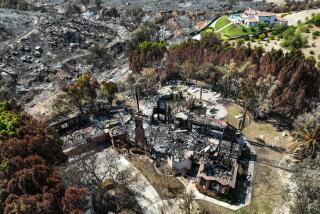GNP Declines 0.1%, Raising Questions About Recovery
The nation’s economy contracted rather than expanded during the second quarter of this year, the government reported Wednesday, casting a pall on the widely held view that the recession had ended last spring.
In a revised report, the Commerce Department estimated that the gross national product, the total amount of goods and services produced by the economy, fell at an annual rate of 0.1% from April through June rather than rising at a 0.4% rate, as reported a month ago.
The department said that the second-quarter drop was primarily attributable to a sharper-than-expected decline in business inventories and weaker consumer spending than had been estimated initially.
The revision is embarrassing for the Bush Administration, which had boasted after the initial report that the economy was growing again after posting recessionary declines of 1.6% in the final quarter of 1990 and 2.8% in the first quarter of 1991.
President Bush expressed little concern, however, when asked about the economy at the golf course near his vacation home in Kennebunkport, Me. “I feel all right about things,” he told reporters. “There’s some statistics up and some down, but, basically, I think it’s doing all right.”
Analysts said that the downward revision, although unexpected, does not necessarily undermine the consensus view that the economy has begun to grow and is likely to keep expanding during the second half of the year.
“To the extent that this revision has any importance, it is that most of it was a decline in inventories,” said economist Bruce Steinberg of Merrill Lynch Capital Markets in New York. “The degree of inventory liquidation during the first half of the year was so strong that it bodes well for growth later on--including the current quarter. We had recession through the first half, but some kind of recovery is now under way.”
According to the revised estimate, the gross national product declined during the second quarter at an annual rate of $1.1 billion to a total of $4.123 trillion, down $5.4 billion from the previous estimate.
The biggest single factor in the revision was a $5.3-billion annual reduction in inventory accumulation by manufacturers, wholesalers and retailers, an adjustment that is expected to contribute to economic growth later on.
U.S. business inventories have been shrinking for three consecutive quarters. Although the shrinkage causes current GNP to appear smaller, it should provide a firm base for a stronger recovery as manufacturers resume higher rates of production. In fact, some economists said that the steady inventory liquidation actually reduces the probability of a second round of recession.
“It is, on the surface, a negative GNP, so lots of people will look at it and say the recession is longer than people thought,” said economist Giulio Martini of Sanford C. Bernstein & Co., a New York investment firm. “But final demand was unchanged in the revision and there was less inventory accumulation than earlier reported, and that’s good.”
Consumer spending, originally reported to have increased at a 3.6% annual rate in the second quarter, was trimmed back to a 2.8% rise. But much of the resulting $5.1-billion reduction is attributable to an accounting adjustment involving vehicle sales and does not signify real economic problems.
Personal disposable income was revised upward by $8.5 billion to an annual rate of $2.9 trillion, a substantial improvement over the first quarter. That revision, in turn, pushed the personal savings rate up to 4.2% from the 3.7% estimated last month.
As a result of a small upward revision in exports of goods and services, final sales of U.S. products to all purchasers, domestic and foreign, are now estimated to have increased at a rate of 0.2% during the quarter, up from last month’s estimate of 0.1%.
“If you look underneath the headline number, things didn’t change all that much . . . “ said analyst David Wyss with DRI/McGraw Hill, a Lexington, Mass., forecasting firm. “Most of the change was inventories, and that helps the second half (of the year). With disposable incomes higher, that suggests people will be coming out of the recession with a higher savings rate than we had thought.”
A separate report issued by the Commerce Department Wednesday also sent mixed signals about the second quarter. Corporate profits from current production increased $1.7 billion, or 0.6%, to an annual level of $287.9 billion, the agency said.
It was the first uptick after three consecutive quarterly declines. But after-tax corporate profits fell for the third consecutive quarter, by 1.6%, or $2.7 billion, to an annual level of $163.7 billion.
More to Read
Inside the business of entertainment
The Wide Shot brings you news, analysis and insights on everything from streaming wars to production — and what it all means for the future.
You may occasionally receive promotional content from the Los Angeles Times.






